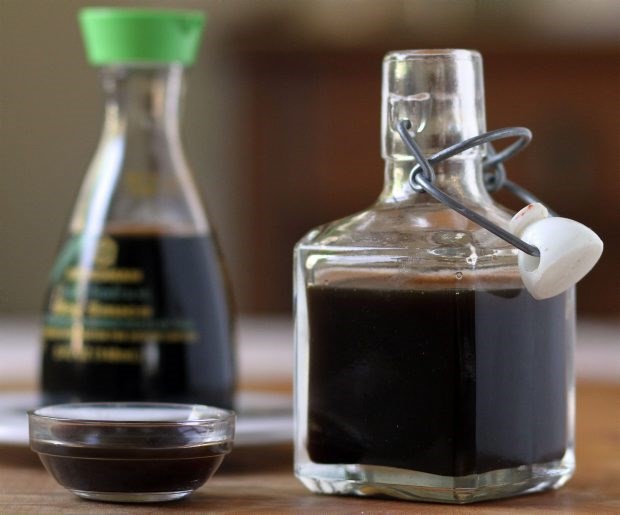Dear Eric: What can I use instead of soy sauce? Many recipes I want to use call for this ingredient and I can't ingest soy proteins.
Vicki Sharp
Dear Vicki: There's really no substitute for the salty, tart, sweet and meaty tastes a good soy sauce can add to a dish, whether it's a stir-fry, marinated meat or noodle bowl.
However, there are recipes for a soy sauce substitute with a somewhat similar look and taste. You make it by blending and simmering ingredients such as meaty beef bouillon or stock, tart vinegar, somewhat sweet and dark molasses and spices.
The end product looks like soy sauce and tastes similar. It doesn't have to be salty, but you can add as much salt as needed to get the flavour you want. The mixture can be used in any recipe calling for soy sauce.
Vicki knows she must avoid all products that contain soy proteins but, unfortunately, some store-bought beef bouillon and stock contain them. So she would have to make it herself or buy a product free of soy. In today's recipe, I used a brand of beef stock called Kitchen Basics. On its website, kitchenbasics.net, the company says it strives to reduce the risk of allergic reactions by barring a wide range of ingredients - including soy - that are considered high risks for them.
Soy sauce substitute
This easy-to-make substitute can be used as you would real soy sauce.
Preparation time: A few minutes
Cooking time: About 10 minutes
Makes: 2/3 cup
1 cup homemade or low sodium or no-salt-added store-bought beef stock
2 Tbsp balsamic vinegar
2 tsp cider vinegar
1 Tbsp plus 1 tsp cooking molasses
pinches white pepper, garlic powder and ground ginger
salt to taste (optional)
Place all ingredients, except salt, in a small pot. Bring mixture to a gentle simmer (small bubbles should just break on the surface), and simmer until reduced to about 2 cup. Sea-/3 son with salt, if desired, or leave as a low-salt condiment. Pour into a tight-sealing jar and refrigerate up to 10 days.
Dear Eric: When using milk in a recipe, which type do you use - skim, one or two per cent or homo? Does it make a difference in the outcome? In a past column, you included a muffin recipe (mini cranberry muffins), which included 1 cup of milk. Will any type do? And when in doubt, is there a standard one? I also wonder about milk in Yorkshire pudding.
Pam White
Dear Pam: You're obviously talking about cow's milk, and I thought I'd start answering your queries by explaining what the various types are.
According to the Dairy Farmers of Canada website, dairygoodness.ca, whole (homogenized) milk contains at least 3.25 per cent milk fat, the natural amount found in cow's milk.
When a portion of that fat is removed (skimmed), it becomes what's known as partly skimmed milk. These products are named for the amount of milk fat that remains, such as two per cent milk and one per cent milk. Skim milk contains 0.1 per cent fat, making its virtually fat-free.
With whole milk being more than 96 per cent fat free, it seems "light" when compared with other dairy products, such as whipping cream, which contains 33 per cent milk fat.
When you taste and compare skim milk with whole milk, however, you will agree the additional milk fat does give it more body and richness. That is why many chefs and cookbooks authors specify whole milk in recipes.
For example, in Regan Daley's book In the Sweet Kitchen, she says that although whole milk has fallen out favour for drinking, it is by far the best to use for baking. She writes that the higher fat content can extend shelf life and adds a smoothness and richness lacking with lower-fat varieties.
Partially skimmed milk, such as two per cent, can be successfully used in baking and dessert making, Daley says, but she stresses it should not be used when whole milk is specified or in recipes that aim for a richer taste, such as ice cream.
Daley says if a recipe specifies skim milk, that is what you should use to get the moistness and texture the original chef achieved.
Several other cookbook authors recommend whole milk for recipes, both savoury and sweet, where the milk is a key component, such as in a white sauce, cream soup, Yorkshire pudding, custard sauce or pudding. If you want them to have the finest, richest taste, whole milk will deliver that.
That said, those authors said partially skimmed or skim milk will work if you don't mind a less-rich taste. And you can enhance the taste by, for example, adding some grated fullflavoured cheese to a white sauce, or by whisking chocolate in a cream pie filling.
Pam, I rarely specify what type of milk to use in a recipe - such as the muffin recipe you mentioned. I usually use one or two per cent milk when I'm cooking - it's what I drink and therefore what I have on hand to cook with. In the future, I'll be clearer on what type to use.
Eric Akis is the author of the bestselling Everyone Can Cook series of cookbooks. His columns appear in the Life section Wednesday and Sunday.



